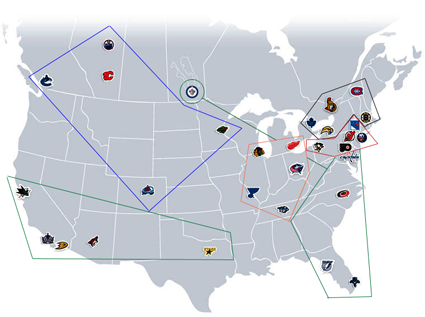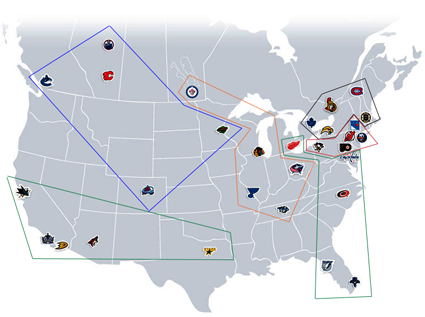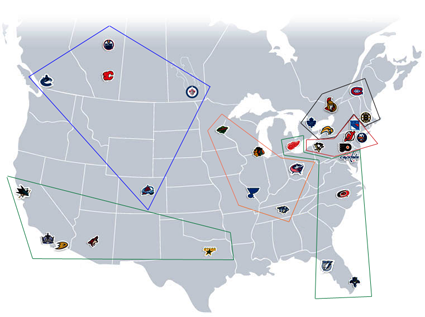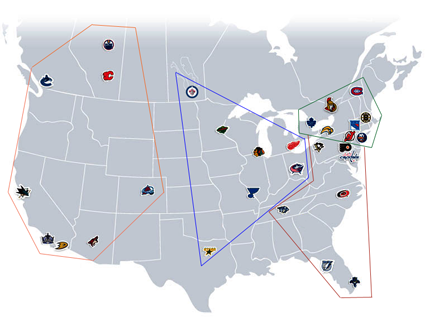With the NHL Governors meetings happening in Florida today and tomorrow, it's time to revisit what has proven to be a popular post we made earlier
necessitated by the relocation of the Atlanta Thrashers from the southeastern United States to central Canada where they became the Winnipeg Jets.
First, let's take a look at where things stand right now.
Current 2011-12 NHL Division Map
The things to note are the compactness of the Northeast and Atlantic Divisions, especially compared with the Northwest and Pacific Divisions in the Western Conference. Also of note are the distances from both Minnesota and Dallas, both located in the Central Time Zone, from all the other teams in their divisions, none of which are even located in the same time zone.
Obviously, with the late relocation of the Thrashers to Manitoba before the 2011-12 season, the Jets were forced to remain in the Southeast Division this season, a situation that all agree needs to be rectified.
Apparently the Governors will vote on which of two proposals they prefer, one of which simply is a straight swap that moves the Detroit Red Wings to the Eastern Conference with Winnipeg taking their place in the Western Conference.
Proposed 2012-13 NHL Realignment - Detroit / Winnipeg straight swap
To us, this is an entirely unacceptable option, as keeping the current divisions relatively unchanged keeps in place some glaring mistakes of the current system, mainly leaving the Dallas Stars stranded in the Pacific Division, 866 miles from their nearest neighbors in Phoenix and still with no other divisional clubs in their time zone, which to us is intolerable. Additionally, Minnesota remains stuck in the Northwest Division along with three teams located in Canada and four teams outside of it's time zone.
Another issue with moving Detroit east in a straight swap, is their now relative isolation 400 miles from their closest division neighbor in Washington D. C. and a long way from the two Florida clubs, with the Panthers being over 1100 miles away.
Often repeated is the fact Detroit wants to move east and has apparently been promised by the NHL that they will be moved when the first opportunity arrives, but Jeff Marek of Sportsnet in Canada has also been mentioning that late Chicago owner Bill Wirtz was also promised that Chicago would never be separated from Detroit, in direct conflict with any promises made to the Red Wings.
Another issue we have with a straight swap is moving Winnipeg to Detroit's place in the Central Division. At the very least we'd put Winnipeg in the Northwest with fellow Ccanadian clubs Vancouver, Edmonton and Calgary and switch Minnesota to the Central with Minnesota's traditional Norris Division rivals Chicago and St. Louis. We know the Canadian teams would welcome Winnipeg and it would take many of the Wild's border crossings out of their travel schedule and group them in with other central time zone clubs, which they would certainly welcome.
Proposed 2012-13 NHL Realignment - Detroit / Winnipeg modified swap
Now let's look at our proposal for 2012-13. To oversimplify, currently the continent west of the Mississippi River is essentially divided horizontally into a northern group (the Northwest Division) and a southern group (the Pacific Division). What we propose is to make the divisional alignments based on vertical divisions, rather than the current horizontal alignments. Additionally, we also would embrace the American Hockey League model, reducing the number of divisions to just four. Each conference would be made of one seven and one eight team division. Having fewer divisions of more teams would allow more clubs to be accommodated as far as their desires to be paired with traditional rivals.
The method we would use to place the teams in each of the four divisions begins in the northeast and places Montreal, Ottawa and Toronto together, adding in Buffalo. The Northeast Division is then completed with the three New York/New Jersey teams as well as traditional New York rival Boston, who stay grouped with their historic rival Montreal.
The remaining seven teams in the east are the two Pennsylvania clubs Philadelphia and Pittsburgh, as well as Washington, who belong in a division with nearby Philadelphia. The four remaining southern teams, Carolina, Nashville, Tampa Bay and Florida round out the Atlantic Division.
In the west, we simply group the eight teams which are the furthest west. The California clubs, San Jose, Los Angeles and Anaheim are grouped with nearby Phoenix and the three western-most Canadian teams, Vancouver, Edmonton and Calgary. Colorado is the final team to complete the West Division, as they inhabit the Mountain Time Zone along with Edmonton, Calgary and Phoenix.
The Central Division is based on grouping Winnipeg, Minnesota and Dallas together since they are located in a relative vertical line. Traditional rivals St. Louis, Chicago and Detroit are then added. Columbus is included due to it's proximity to Detroit.
Yes, we would keep Detroit in the west, refusing to separate long standing Original 6 rivals Detroit and Chicago, two cities who are in the same division in the three other professional sports leagues, the NBA, NFL and MLB.
Our 2012-13 NHL Realignment 4 Division Proposal
How clean and simple is that? In addition to grouping the teams in a more fair and logical way, even more importantly, the playoffs would return to the system once used by the NHL, where the first two rounds of the playoffs would be played exclusively within your own division among the top four clubs in each division. The benefit of this system would be the increased number of times clubs would face the same teams during the playoffs as the years would go by, and if there's one thing we will scream from the top of our lungs, it's that rivalries are created during the playoffs. Playing the same teams over and over during the regular season makes for repetitious boredom, while playing to end your opponent's season creates an intensity and drama you just can't get anywhere else.
Two rounds of playoffs among the same seven teams in your division gives you a 1-in-3 chance of facing the same team as the previous year, when compared to a 1-in-7 chance of repeating an opponent from the previous season as it stands now within a 15 team conference. In reality, the odds of facing the same team as a previous season actually improves in the short term when you factor in successful teams making the playoffs more often while they are in periods of greater success.
The NHL would likely then have the division winners in each conference face each other to determine a conference champion, but we'd like to see the final four teams seeded by points
regardless of conference. This would have several benefits, the first being that if two strong teams advanced from one conference and the lowest two from the other,
as happened in 2002-03, this system would increase the chances of the most competitive Stanley Cup Finals possible as well as allowing for the possibility of an occasional Philadelphia vs. New York or Boston vs. Pittsburgh final not possible now with the East vs. West format. The TV networks should also appreciate the chance for two huge eastern population centers facing off for the Stanley Cup now and then.
After implementing this alignment, we'd also adjust the schedule to include playing every team in the league at home every year in the manner of the NBA schedule.
The breakdown would be;
If you are in the seven team division;
- You play the 15 teams in the other conference twice a year = 30 games
- You play the 8 teams in the other division of your conference twice a year = 16 games
- You play the other 6 teams in your division 6 times a year = 36 games
If you play in the eight team division;
- You play the 15 teams in the other conference twice a year = 30 games
- You play the 7 teams in the other division of your conference twice a year = 14 games
- You play the other 7 teams in your division 5 times a year = 35 games
- You play the remaining 3 games in your division among the other 7 teams on a rotating annual basis = 3 games
It's a topic there are naturally many, many solutions to and opinions on, so feel free to add yours in the comments below.















I definitely love your solution! I've always strongly disliked both the 6-division system and the dismissal of the divisional playoffs. As I commented on your previous post about this subject, I had already planned on my own a 4-division realignment that ended up in a solution very, very similar to yours.
ReplyDeleteThe only main difference is, I am a purist of the East vs West playoff format, so I would keep separate East-West brackets until the Stanley Cup Finals.
Anyway, awesome post!
PS: my ideal number of teams for a league like the NHL is 24-26.
No matter the alignment decided upon, people aren't going to be happy. Personally, I find the teams inside the division play each other to often. If I'm not mistaken, Florida and Tampa Bay have already played each other five times.
ReplyDelete